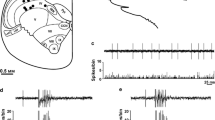Abstract
Chronic daily headache (CDH) is a particularly difficult type of headache to manage, with an uncertain pathophysiology. Intravenous administration of lignocaine has been suggested as a possibly useful option in the control of this syndrome. We have surveyed prospectively patients with CDH (selected for this study as those with 6 or more months of continuous pain with at least weekly exacerbations that, taken in isolation, would fulfil International Headache Society diagnostic criteria for migraine without aura). Intravenous lignocaine (2 mg/min) by infusion over a 2-day period rendered 26% of patients pain free, with a further 42% having at least a 50% improvement in the pain. Continued benefit was associated with commencement of prophylaxis with a tricyclic antidepressant or monoamine oxidase inhibitor after completion of the lignocaine infusion. In an animal model of craniovascular nociception, using electrical stimulation of the superior sagittal sinus and recording of single unit activity and sensory evoked potentials in the spinal trigeminal nucleus in the upper cervical spinal cord of the anaesthetised cat, the effect of lignocaine was examined. Lignocaine reduced both the probability of cell firing and the size of the trigeminal evoked potential in the animals studied. The reduction was both substantial (more than 25% in each case) and dose-dependent. Taken together the data suggest that CDH is likely to be a disorder of central craniovascular nociceptive control and that lignocaine acts to interrupt a part of the pathway involved but is unlikely to act at the central generator of the disorder.
Similar content being viewed by others
References
Jauslin P, Goadsby PJ, Lance JW (1991) The hospital management of severe migrainous headache. Headache 31:658–660
Saper JR (1986) Changing perspectives on chronic headache. Clin J Pain 2:19–28
Sheftell FD (1992) Chronic daily headache. Neurology 42 [Suppl 2]:32–36
Olesen J (1988) Classification and diagnostic criteria for headache disorders, cranial neuralgias and facial pain. Cephalalgia 8 [Suppl 7]:1–96
Kudrow L (1982) Paradoxial effects of frequent analgesic use. Adv Neurol 33:335–341
Pfaffenrath V, Isler H, Ekbom K (1993) Chronic daily headache. Cephalalgia 13 [Suppl 12]:66–67
Maciewicz R, Borsook S, Strassman A (1988) Intravenous lidocaine relieves acute vascular headache. Headache 28:309
Reutens DC, Fatovich DM, Stewart-Wynne EG, Prentice DA (1991) Is intravenous lignocaine clinically effective in acute migraine? Cephalalgia 11:245–247
Edwards TW, Habib F, Burney RG, Regin G (1985) Intravenous lidocaine in the management of various chronic pain states. A review of 211 cases. Anaesthesiology 10:1–6
Rowbotham MC, Reisner-Keller LA, Fields HL (1991) Both intravenous lidocaine and morphine reduce the pain of postherpetic neuralgia. Neurology 41:1024–1028
Goadsby PJ, Zagami AS (1991) Stimulation of the superior sagittal sinus increases metabolic acitivity and blood flow in certain regions of the brainstem and upper cervical spinal cord of the cat. Brain 114:1001–1011
Siegel S (1956) Non-parametric statistics for the behavioural sciences. McGraw-Hill, Kogakusha, Tokyo
Raymond SA, Gissen AJ, Burchiel KJ (1987) Mechanisms of differential nerve block. In: Strichartz GR (ed) Local anesthetics. Springer, Berlin Heidelberg New York, pp 95–164
Tanelian DL, MacIver MB (1991) Analgesic concentrations of lidocaine suppress tonic A-delta and C fibre discharges produced by acute injury. Anesthesiology 74:934–936
Woolf CJ, Wiesenfeld-Hallin Z (1985) The systemic administration of local anesthetics produces a selective depression of C-afferent fibre evoked activity in the spinal cord. Pain 23:361–374
Mathew NT, Stubits E, Nigam M (1982) Transformation of migraine into daily headache: analysis of factors. Headache 22:66–68
Mathew NT (1987) Transformed or evolutional migraine. Headache 27:305–306
Merikangas KR, Isler H, Pfaffenrath V (1993) Classification of headache: methods and empirical data. Cephalalgia 13:1–96
Mathew NT (1988) Amelioration of ergotamine withdrawal symptoms with the use of the nonsteroidal anti-inflammatory agent naproxen. In: Diener HC, Wilkinson M (eds) Drug-induced headache. Springer, New York Berlin Heidelberg, pp 150–156
Diener HC, Haab J, Peters C, Ried S, Dichgans J, Pilgrim A (1990) Subcutaneous sumatriptan in the treatment of headache during withdrawal of drug-induced headache. Headache 31:205–209
Kaube H, Hoskin KL, Goadsby PJ (1993) Sumatriptan inhibits central trigeminal neurons only after blood-brain barrier disruption. Br J Pharmacol 109:788–792
Kaube H, Hoskin KL, Goadsby PJ (1993) Intravenous acetylsalicylic acid inhibits central trigeminal neurons in the dorsal horn of the upper cervical spinal cord in the cat. Headache 33: (in press)
Raskin NH (1986) Repetitive intravenous dihydroergotamine as therapy for intractable migraine. Neurology 36:995–997
Lambert GA, Lowy AJ, Boers P, Angus-Leppan H, Zagami A (1992) The spinal cord processing of input from the superior sagittal sinus: pathway and modulation by ergot alkaloids. Brain Res 597:321–330
Goadsby PJ, Gundlach AL (1991) Localization of [3H]-dihydroergotamine binding sites in the cat central nervous system: relevance to migraine. Ann Neurol 29:91–94
Baumgartner CP, Wessely P, Bingol C, Maly J, Holzner F (1989) Long term prognosis of analgesic withdrawal in patients with drug-induced headaches. Headache 29:510–514
Author information
Authors and Affiliations
Rights and permissions
About this article
Cite this article
Kaube, H., Hoskin, K.L. & Goadsby, P.J. Lignocaine and headache: An electrophysiological study in the cat with supporting clinical observations in man. J Neurol 241, 415–420 (1994). https://doi.org/10.1007/BF00900958
Received:
Revised:
Accepted:
Issue Date:
DOI: https://doi.org/10.1007/BF00900958



